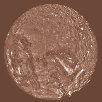
|
Diameter: 31,800 miles (51,100 km). |
|
Mass: 14.5 Earth masses |
|
Rotation period: 0.72 days, retrograde. |
|
Inclination of equator to orbit: 97.9 degrees. |
|
Mean orbital speed: 4.2 Miles per second (6.8 km/s) |
|
Mean distance from the sun: 1.8 billion miles (2.9 billion km) |
| THE STRUCTURE OF URANUS Uranus is some 1.8 billion miles from the sun, and little was known about the planet until recent times, with most of our knowledge coming from a single spacecraft – Voyager 2 – which passed by the planet in 1986. Uranus has its rotational axis orientated close to its orbital plane, essentially it orbits on its side. This has strange consequences. During its 84 year orbital period , each pole spends 42 years in darkness followed by 42 years in direct sunlight. One would surmise that the extra solar energy received at the poles would result in higher temperatures there, but in actual fact this is not the case. Temperatures are still higher at the equator because the planets dense atmosphere acts as an insulator, and it takes the atmosphere longer than Uranus's orbital period to heat up or cool off. Like the other gas giants Uranus is thought to have a small rocky core enveloped in a thick layer of liquid ice and rock. However unlike Jupiter and Saturn it lacks a layer of metallic hydrogen. The planet's outer layer consists largely of hydrogen and helium, though in much smaller proportions than in the two larger gas giants. At high altitudes the atmosphere is so cold that methane and ammonia condense into clouds of ice crystals. The methane is largely responsible for the planets blue green colour in that it absorbs red light in the upper atmosphere. RINGS AND MOONS Like the other gas giants Uranus also has rings, and like Jupiter's they are very dark, yet also like Saturn's they are composed of fairly large particles ranging up to ten miles in diameter in addition to the fine dust. At present there are eleven known rings which are all very faint, with the brightest one being the Epsilon ring. These rings were the first to be discovered after those of Saturn, which was important since we now know that rings are a common feature of planets. They were detected by earth based astronomers in 1977 and confirmed by Voyager. Voyager 2 discovered ten small moons in addition to the five large ones already known, yet it is likely that there may be several more tiny satellites within the rings. Indeed at this point in time a subsequent twelve have been discovered – making a grand total of 27. Most of these moons are tiny worlds of rock and ice only 20–60 miles across (25–100 km), but the five primary satellites visible from earth range in diameter from about 1000 miles to 300 miles. Titania is the largest, about half the size of our moon, but it is a much smaller moon that may hold more interest. Voyager images of Miranda show three totally distinct types of terrain juxtaposed to each other, cratered plains, bright cliffs and scarps, and grooved regions extending nearly 200 miles across the surface. There is a possibility that Miranda was shattered in a collision and the pieces subsequently resembled, but at this point in time we don't know for sure. Ariel has the brightest and possibly the youngest surface among all moons of Uranus. It has few large craters and many small ones, indicating that fairly recent low impact collisions wiped out the large craters that would have been left by much earlier, bigger strikes. Intersecting valley's pitted with craters scars the surface. Umbriel is ancient, and the darkest of the five large moons. It has many old large craters and sports a mysterious bright ring on one side. Oberon, the outermost of the five major moons, is old, heavily cratered, and shows little signs of internal activity. Unidentified dark material appears on the floors of many craters.
|
![]() Copyright(C) 2007
- 2020. All rights reserved.
Copyright(C) 2007
- 2020. All rights reserved.



